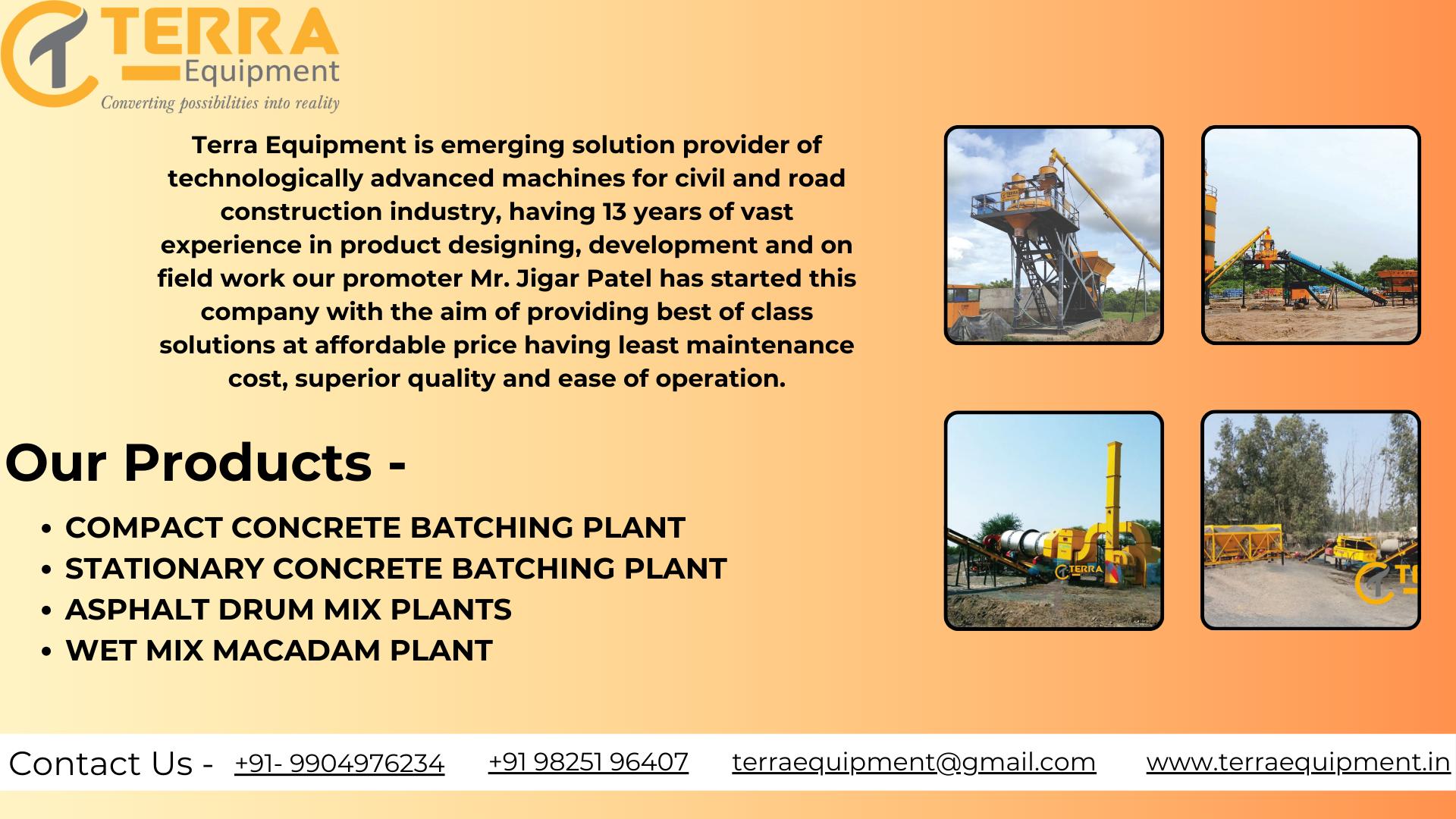Introduction — Top Batching Plant Manufacturers in India
terraequipment delivers high-accuracy concrete batching plants for India’s toughest projects, in stationary, mobile, and compact formats. Systems use load-cell dosing, twin-shaft or planetary mixers, and PLC/HMI automation with recipe control to produce consistent slump and strength while reducing cement waste. Moisture compensation and fast cycle times boost throughput; rugged frames, sealed conveyors, and dust control cut downtime. Modular skids and bolt-on silos speed installation and relocation. From urban sites to highways and precast yards, terraequipment provides application sizing, calibration, commissioning, and responsive after-sales support—so your plant ramps up quickly, runs safely, reliably, and stays consistently on spec, shift after shift.
Working Principle & Process Flow — Batching Plant
terraequipment batching plants produce uniform concrete by weigh-dosing each ingredient per recipe, then mixing at controlled speed/time. A PLC/HMI coordinates aggregate gates, cement screw, water/admixture pumps, and mixer cycle. Moisture probes auto-correct aggregate water, ensuring target slump without excess cement. All events are logged for QA and traceability.
Applications & Benefits — Batching Plant
- Ready-mix supply for urban/commercial projects (M20–M50).
- Roads & highways: PQC/DLC with slip-form pavers.
- Precast / pre-stressed yards: sleepers, girders, hollow-core.
- Bridges, metro, airports: high early-strength, pumpable mixes.
- Bridges, metro, airports: high early-strength, pumpable mixes.
- Accurate dosing + moisture compensation → consistent slump/strength and lower cement waste.
- Automated sequencing + fast cycles → higher hourly throughput.
- Rugged frames, sealed conveyors, dust control → less downtime and cleaner sites.
- Complete batch logs & remote diagnostics → stronger QA & compliance.
Key Features — Batching Plant
- Load-cell dosing with PLC/HMI recipe control for consistent accuracy.
- Moisture probes with auto-compensation to hit target slump and reduce cement waste.
- Twin-shaft/planetary mixers with optimized dry–wet cycles for fast homogeneity.
- Modular mobile/compact/stationary layouts; bolt-on silos & conveyors for quick setup/relocation.
- Sealed conveyors, dust control, guarded drives, and remote diagnostics for clean, safe, low-maintenance operations.
Top Manufacturers & Suppliers in India
When shortlisting batching plant partners in India, prioritize accurate dosing, robust mixers, clean site operation, documentation, and fast support. terraequipment ticks these boxes with load-cell dosing, twin-shaft/planetary mixers, moisture compensation, and PLC/HMI control for full traceability. Modular stationary, mobile, and compact plants speed installation and relocation, while sealed conveyors and dust control keep sites compliant and tidy. Every supply includes GA drawings, calibration support, and batch reports; our team handles sizing, commissioning, operator training, and after-sales service. With standardized spares, responsive pan-India support, and reliable uptime, terraequipment is a dependable choice among top manufacturers and suppliers for concrete batching plants in India.
Maintenance & Safety Tips — Batching Plant
Monthly / Quarterly
- Change gearbox oil as per OEM; grease bearings; check mixer liners/paddles for wear and clearances.
- Validate moisture probe, flow meters, and load cells with test weights/volumes; update certificates.
- Inspect silo safety: pressure relief valves, over-fill alarms, fill line gaskets and camlocks.
Operating Best Practices
- Keep housekeeping tight: no cement build-up on weigh hoppers/mixer lips; clean after each shift.
- Don’t bypass interlocks; use recipe management and ramp sequences—avoid “manual shortcuts”.
- Maintain safe access: anti-slip platforms, guard chains at discharge, adequate lighting.
FAQs — Batching Plant
Q1 How do I choose the right plant capacity?
Q2 Twin-shaft vs. planetary mixer—what’s better for me?
Q3 How does moisture compensation improve quality?
Q4 What is the typical installation/commissioning time?
Q5 What documentation and compliance do you provide?
Get in Touch
Terra Euipment • We’re here to help
Relevant Tags
- Top batching plant manufacturers in india
- Concrete Batching Plant manufacturers in India
- Top 10 concrete Batching Plant manufacturers
- Batching Plant company list
- Batching Plant manufacturers in Gujarat
- Concrete batching plant company names
- top batching plant manufacturers in india
- concrete batching plant manufacturers in india
- mobile concrete batching plant
- stationary concrete batching plant
- rmc batching plant manufacturer india
- concrete batching plant price in india

